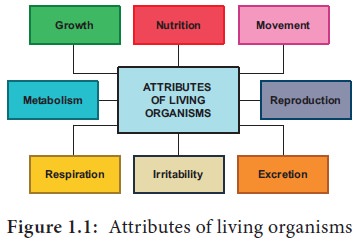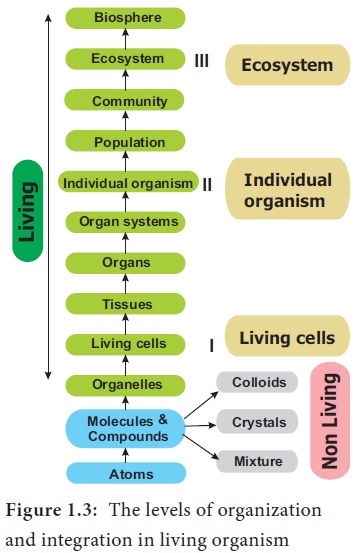Botany - Attributes of living organisms | 11th Botany : Chapter 1 : Living World
Chapter: 11th Botany : Chapter 1 : Living World
Attributes of living organisms

Attributes of living organisms
The attributes of living organisms are given below
and is represented in Figure 1.1

Growth
Growth is an intrinsic property of all living
organisms through which they can increase cells both in number and mass.
Unicellular and multicellular organisms grow by cell division. In plants,
growth is indefinite and occurs throughout their life. In animals, growth is
definite and occurs for some period. However, cell division occurs in living
organisms to repair and heal the worn out tissues. Growth in non-living objects
is extrinsic. Mountains, boulders
and sand mounds grow by simple aggregation of material on the surface. Living
cells grow by the addition of new protoplasm within the cells. Therefore,
growth in living thing is intrinsic.
In unicellular organisms like bacteria
and amoeba growth occurs by cell division and such cell division also leads to
the growth of their population. Hence, growth and reproduction are mutually
inclusive events.
![]()
![]()
![]()
Cellular structure
All living organisms are made up of cells which may
be prokaryotic or eukaryotic. Prokaryotes
are unicellular, lack membrane
bound nuclei and organelles like mitochondria, endoplasmic reticulum, golgi
bodies and so on (Example: Bacteria and Blue green algae). In Eukaryotes a definite nucleus and
membrane bound organelles are present. Eukaryotes may be unicellular (Amoeba) or multicellular (Oedogonium).
Reproduction
Reproduction is one of the fundamental
characteristic features of living organisms. It is the tendency of a living
organism to perpetuate its own species. There are two types of reproduction
namely asexual and sexual (Figure 1.2). Asexual reproduction refers to the
production of the progeny possessing features more or less similar to those of
parents. The sexual reproduction brings out variation through recombination. Asexual reproduction in
living organisms occurs by the production of conidia ( Aspergillus, Penicillium),
budding (Hydra and Yeast), binary fission (Bacteria and Amoeba) fragmentation (Spirogyra), protonema (Mosses) and
regeneration (Planaria). Exceptions
are the sterile worker bees and mules.

Types of Asexual Reproduction
(a) Conidia formation-Penicillium, (b) Budding-Yeast, (c) Fragmentation-Spirogyra, (d) Regeneration-Planaria
Response to stimuli
All organisms are capable of sensing their
environment and respond to various physical, chemical and biological stimuli.
Animals sense their surroundings by sense organs. This is called Consciousness. Plants also respond to
the stimuli. Bending of plants towards sunlight, the closure of leaves in
touch- me-not plant to touch are some examples for response to stimuli in
plants. This type of response is called Irritability.
Homeostasis
Property of self -regulation and tendency to
maintain a steady state within an external environment which is liable to
change is called Homeostasis. It is
essential for the living organism to maintain internal condition to survive in
the environment.
![]()
![]()
![]()
Movement, Nutrition, Respiration and Excretion are
also considered as the property of living things.
The levels of organization in living organism begin
with atoms and end in Biosphere.
Each level cannot exist in isolation instead they form levels of integration as
given in Figure 1.3.

Metabolism
The sum total of all the chemical reactions taking
place in a cell of living organism is called metabolism. It is broadly divided into anabolism and catabolism. The
difference between anabolism and
catabolism is given in Table 1.1

Activity 1.1
Collect Vallisneria
leaves or Chara from nearby aquarium
and observe a leaf or Chara thallus
(internodal region)under the
microscope. You could see cells clearly under the microscope. Could you notice
the movement of cytoplasm? The movement of cytoplasm is called cytoplasmic
streaming or cyclosis.
Related Topics